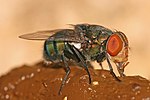Coprophagia
As Koprophagie (from Greek κόπρος kópros , Dung ',' crap ',' Kot 'and φαγεῖν phagein , eat'), the consumption of feces (feces) is called.
Animals
Coprophages are divided into two groups:
- Allocoprophages feed on excrement from other animal species.
- Autocoprophages eat their own droppings or the droppings of other species (see Caecotrophy ).
Allocoprophages
Many saprophages use those organic substances that are still contained in the dung of other animals as coprophages . They therefore represent an important element in the ecological cycle of matter. Examples of these animal groups are various nematodes , mites or some scarab beetles such as the dung beetle and the sacred pill turner (Scarabaeus sacer).
Autocoprophages
The species that eat their own excrement include rabbits , hares, and many rodents such as guinea pigs and chinchillas , as well as dogs and the equidae family . They are often not able to adequately absorb the plant-based food (nutrients, vitamins) through a single intestinal passage. Similar to ruminants, the production of proteins is carried out by symbiotic bacteria , which, however, are located in the appendix (“fermentation chamber”, between the small and large intestines). Since protein is absorbed in the small intestine, the feces including the secreted proteins must be eaten again.
Koprophagie also comes with monkeys , and apes such. B. the gorillas, also here presumably in order to make better use of plant-based food or if there is a lack of nutrients. As a symptom of a disorder, coprophagia in animals has been linked to boredom and thiamine deficiency .
Also among the Koprophagen include some species of surgeonfish . These are very poor feed converters, so that their droppings often still contain half-digested plant residues. By eating feces, these fish avoid the loss of pre-digested food, cellulose-splitting digestive enzymes and microorganisms in the nutrient-poor coral reef .
human
In humans, coprophagia is sometimes viewed as a sub-form of pica syndrome and is mainly seen in psychological and neurological disorders. Diseases that can be associated with coprophagia are
- Alcohol sickness and delirium
- Dementia , as an organic mental disorder
- Brain atrophy and brain tumors
- Mental retardation
- schizophrenia
- Obsessive-compulsive disorder
- Forms of autism
Therapeutic come a psychotherapy , for example, a behavioral therapy or pharmacotherapy, for example, haloperidol and newer, so-called. Atypical neuroleptics (a case report on the effectiveness of Perospiron ) and electroconvulsive used.
Coprophagia can also occur as an appearance of coprophilia (an excrementophilia ; thus the special form of paraphilia ), with the faeces being used here as a fetish . Eating or having to eat (in the sense of “being forced”) from faeces is also found as a variant in (mostly sadomasochistic ) sexual practices (see also coprophilia).
literature
- Stephan Dressler, Christoph Zink: Pschyrembel Dictionary Sexuality . Walter de Gruyter, Berlin 2003, ISBN 3-11-016965-7 .
Web links
- DA Beck, NR Frohberg: Coprophagia in an elderly man: a case report and review of the literature. In: International journal of psychiatry in medicine. Volume 35, Number 4, 2005, pp. 417-427, ISSN 0091-2174 . PMID 16673841 . (Review).
Individual evidence
- ↑ DL Wells: Comparison of two treatments for preventing dogs eating their own faeces. In: Vet Rec. 153 (2), Jul 12, 2003, pp. 51-53. PMID 12885213
- ^ SR Shadwick, MD Ridgway, A. Kubier: Thyrotoxicosis in a dog induced by the consumption of feces from a levothyroxine-supplemented housemate. In: Can Vet J. 54 (10), Oct 2013, pp. 987-989. PMID 24155422
